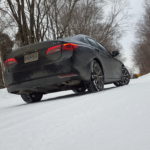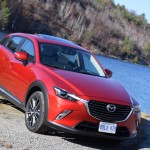Because of my line of work, I’m asked the same question, frequently, when it gets cold outside: “What’s the best winter tire?”
(Originally Published February 2014 via www.autos.ca)
My answer is usually met with surprise, because I’m of the belief that there’s no such thing as a ‘best’ winter tire.
There are winter tires that are better than others at certain things—depending on what you drive, how you drive it, what you drive it on, where you live, the prevailing weather conditions there, and what you’re after from your ride in the colder months. But there’s no best winter tire.
So the question is typically re-posed thusly: “Well, which winter tire would you put on your own car?”
Ah. That question is a fair bit easier—and one I have an answer to. That answer is Michelin X-Ice winter tires.
Let me pause and qualify a few facts.
I don’t do product placements. Nobody at Michelin has requested or compensated me to say their winter tire is my favorite. My opinion is not based on press materials or samples provided by Michelin, either. Instead, it’s based on some 1,800 kilometers a week spent driving, largely, on the highways of Central and Northern Ontario, every week of the year, for nearly 12 years now. In wintertime, this driving includes many different vehicles, wearing many different types of winter tires. It also includes a weekly pass through what us Northerners call the ‘Snow Belt’, which is a climatically-unpredictable stretch of highway leading north towards Sudbury which always seems to be in a crappy mood.
So, I always check which brand and model of tire I’m driving on, making a mental note of how they perform for future reference. As such, I’ve been consistently impressed with X-Ice rubber for years, though this year’s relentlessly-bad winter weather and the consistently-terrible highway clearing have cemented them as my personal favorite.
Why?
I’ll need to qualify something before explaining fully: it’s my belief that the majority of experienced drivers in the majority of vehicles travelling carefully on winter roads will be concerned primarily with being able to stop should a hazard present itself. For your writer and many other motorists doing their best to drive according to the conditions and keeping their eyes as far up the road as possible, I’d argue that excellent delivery of stopping power is the winter-tire attribute of highest importance.
And that’s where the X-Ice rubber always lives up to my praise. One could argue the intricacies of winter tire dynamics in terms of directional stability, how predictably traction gives way to skidding, how crisply the tires bite when cornering is requested, or how slippery or sticky the tires feel when drivers smash on the throttle. Yes– some winter tires may steer with more precision on ice, feel more stable in deep snow or provide more off-the-line grip for quickly getting out of a traffic light when the pavement is cold, but the X-Ice tires have a consistently good ‘bite’ under braking on any surface I’ve ever used them to stop on.
You see a jack-knifed transport up the highway. Or a sea or brake lights as you come around a corner. Or notice through the heavy snowfall that there’s a broken-down snow-plow in the roadway ahead of you. Provided you’re looking far enough ahead, which you should be, your first reaction will be to brake—not to steer or accelerate—and that’s where the X-Ice tires shine.
I’ve noted far more brake pedal application required to engage the antilock-brake function when stopping on X-Ice rubber in a variety of vehicles ranging from SUV’s to sports coupes to family sedans. This means the ABS system has more traction—so it engages later, and works better when it does. Whether it’s the rubber compound, tread pattern or some combination of other factors, the X-Ice rubber, in my experience, simply feels consistently able to find a surprising level of stopping traction on more types of slippery surfaces than any other winter tire I’ve tried.
So there you have it. If you’re a big time fan of being able to stop as quickly as possible on slippery roads, Michelin X-Ice tires are, likely, the best winter tire, and shouldn’t disappoint.
I’ll also note, depending on your budget and priorities in a winter tire, that I’ve also found the BF Goodrich Winter Slaloms to be all-around confidence inspiring, especially with stopping power. Pirelli Sotozero winter rubber is also worth a note. The consistently impressive trait your writer notices on these isn’t the stopping bite, but rather, their ability to clear even thick, heavy slush from their treads at higher speeds. This is a sportier winter tire—and if your winter driving is more likely to take place on wet and slushy highways at higher speeds, you won’t go wrong with these.
Here’s some more useful information on winter tires, and winter tire testing.





